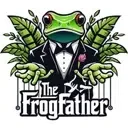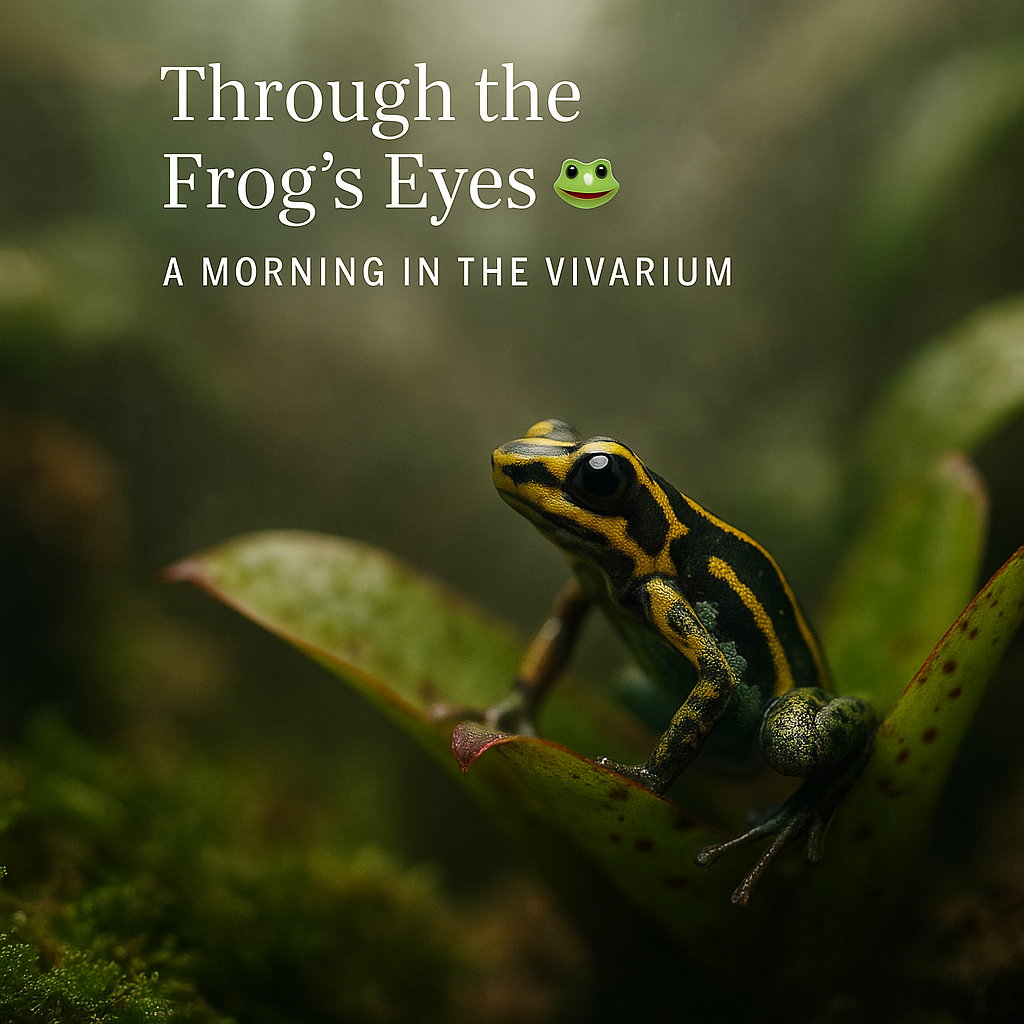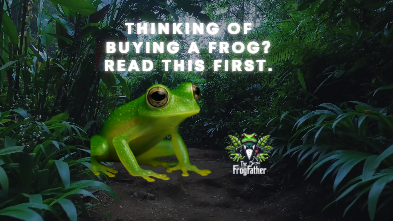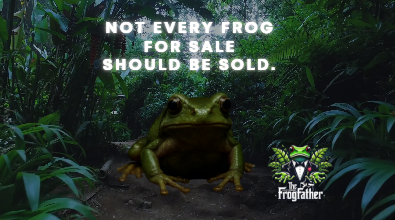The mist lingers like breath against the glass. Droplets gather on broad leaves, refracting the first threads of light that slip between the vines. Somewhere beneath them, a small shape stirs — Ray, a Ranitomeya variabilis, the dart frog whose world begins when the rest of ours still feels half asleep.
From where he crouches beneath a bromeliad cup, the air is heavy and alive. Every scent, every shimmer matters. He blinks once, and the entire vivarium blooms into motion — colours that pulse and dance, vibrations that hum through the moss and driftwood. What we call green or brown is, to Ray, an orchestra of shifting hues. To him, the world is never still. It sings in ultraviolet.
A World Lit Differently
Light doesn’t just brighten Ray’s world; it defines it. As droplets slide from one leaf to the next, beams scatter into a thousand spectral fragments. To human eyes, it’s condensation. To Ray, it’s communication — an iridescent map that tells him where warmth lies, where movement stirs, and where the shadows are safe.
Above, the Arcadia Jungle Dawn LEDs shift from a cool, pre-dawn tone to soft gold. The light risers spread it evenly, mimicking the dapple of a rainforest canopy. Ray’s body glows faintly under it — the blues more electric, the yellow bands warming as his skin absorbs what the leaves reflect. The forest inside his glass walls has no sunrise or sunset of its own, only rhythm and routine. But through Ray’s eyes, it’s always morning somewhere.
Sound You Can See
Ray doesn’t hear sound the way we do. He feels it. The buzz of springtails scurrying through leaf litter, the quiet drip from a bromeliad, the distant hum of a misting system preparing to start again — they vibrate through the substrate and into his tiny frame. Each note is a pulse in the living architecture of his home.
When the misters finally release their rain, the droplets tap like percussion against the leaves. He hops forward into the open. For a few seconds, he’s nothing but motion and colour — a small flash of living pigment in a storm made of light and humidity. The water beads on his skin, but he doesn’t flinch. It’s familiar, comforting. His world was built to feel alive.
How Ray Sees You
If Ray could look back at us through the glass, he would see little more than shadows and blur. The human face lacks the sharp motion cues he’s tuned to detect. Yet he senses our presence in the vibrations we cause, the rhythm of footfalls, the sudden shift in pressure when the lid opens. He knows the world changes when we come near, though not why. We are shapes, reflections, and scent — strange storms on the edge of his horizon.
When we adjust his lighting or misting schedule, we unknowingly alter the landscape of his perception. A few degrees of warmth, a change in light angle — these are tectonic shifts to Ray. They decide when he hunts, when he calls, when he rests. The ecosystem doesn’t revolve around him; it breathes with him.
The Language of Light and Leaf
Every part of Ray’s vivarium speaks in a language of cues. The leaves signal when humidity peaks. The air changes weight before rain. Even the reflections on the glass mark boundaries between the known and the unreachable. To Ray, reflections aren’t barriers; they’re moving skies, ghostly landscapes he can’t touch but still reads like weather.
His world is perfectly tuned — the bioactive system beneath him thrives unseen, the moss drinks, the isopods turn decay to life. Each detail supports another. We design vivariums for beauty, but Ray experiences them as survival — an art form in which light, sound, and texture combine into one endless dialogue.
The Moment Between Rain and Light
The mist fades. The air still glows faintly, each droplet a lens bending light in ways human eyes can’t follow. Ray pauses on a branch, perfectly still. His heartbeat slows, his throat pulses. In the quiet aftermath of rain, his world feels wider than ours ever could. The plants exhale, the water pools shimmer, and Ray becomes just another note in the rainforest’s breathing song.
It’s easy to forget that this tiny life — hidden behind glass — experiences more colour, vibration, and light than we can comprehend. Every flicker is data. Every ripple of air is meaning. And every sunrise, even the artificial one controlled by timers and LEDs, is an invitation to see again.
Tomorrow, when the lights hum to life once more, Ray will be waiting — poised at the edge of a leaf, seeing the world in a way we never will.
Want to See What Ray Sees?
If you’ve ever wondered what the world looks like through a dart frog’s eyes — how they perceive ultraviolet light, motion, and colour — don’t miss our next feature: What Dart Frogs See That You Don’t – A Look at Frog Vision. Publishing 25/10/25 on frogfather.co.uk.



